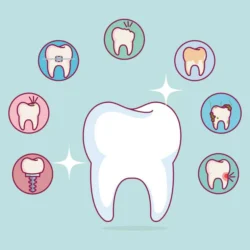Our teeth are fundamental to so many of our core functions, granting us the ability to chew food and speak properly, all while boosting our physical appearance. While teeth are resilient members of the human anatomy, they require tender love and care to ensure they remain healthy and happy.
Adopting a robust and routine oral care regimen is the best method to ward off serious complications in your smile, especially in preventing tooth decay.
Bacteria is to Blame
Bacteria building up over time is often the primary culprit causing tooth decay. This build up, or plaque, is a clear and sticky substance, which eats away at the integrity of the teeth. There is a multitude of possible factors which dictate the amount of bacteria amongst the teeth, and make you more susceptible to developing tooth decay. Some of these include;
- A diet high in sugar and other carbohydrates, which accelerate bacteria development.
- A lack of fluoride, a mineral which enforces teeth, making them more resilient- present in tooth paste and even the water we drink.
- Not producing enough saliva to effectively wash away food particles and harmful sugars. This can be linked to medical conditions, medications, mouth breathing, or old age.
- Diseases like diabetes may have residual impacts on the state of your smile.
- The usage of tobacco products in any form will inevitably harm the teeth, including; smoking, chewing, and even second-hand smoke inhalation.
While these factors are all relevant and impact plenty of patients, the most common cause of tooth decay remains perhaps the simplest…
That is, of course, not brushing and flossing the teeth frequently and thoroughly enough to ward off bacteria buildup!
The Targets of Tooth Decay
Tooth decay can range in severity, depending on how long it has been left unattended to and how far it has reached into the interior of the tooth. In terms of the tooth, it is constructed of three crucial layers;
- The enamel is the outer shell of the tooth- the hardest tissue in the human body.
- The dentin lies beneath, and consists of yellowish tissue which supports the enamel atop.
- The pulp is the sensitive inner core of the tooth, containing nerves and blood vessels.
These layers lend their function to one another and are all equally crucial to any and every tooth in your smile’s arsenal. However, if tooth decay progresses beyond its earlier stages and seeps past the outer enamel, it becomes a more pressing matter.
The Early Stage and Beyond
The stage of the tooth decay will determine the necessary approaches and procedures a dental professional will need to perform in order to restore your teeth to their optimal state. These different stages follow the progression of tooth decay, and consist of the following:
Demineralization: The Early Stage
The initial stage of tooth decay. It occurs when the enamel, or outer layer of the tooth, is continuously exposed to the acids produced by oral bacteria. This leads to vital minerals which coat the enamel being striped away from its surface, often leaving a spotty white pattern in its place.
It is important to understand that this is not yet a cavity, but provides the cavity an ideal area to develop. Luckily, if caught early enough by a dental professional there are ways to halt its development and restore the tooth’s integrity.
This usually calls for a fluoride treatment! Performed by a dental professional, this process enforces the enamel and grants the teeth access to this key mineral so necessary for its function. A foaming gel is also applied to the entire surface of the teeth following a deep cleaning session. Many dental professionals will also send patients home with specialized fluoride toothpastes, designed to rectify demineralization at home over time.
Enamel Decay: The Common Cavity
This is where the decay begins to take a more direct form, and further break down the enamel. Giving space for cavities, in the form of holes, to take form throughout the surface of the teeth. Unlike the demineralization stage, this unfortunately cannot be reversed-however, it can easily be fixed!
Most of us at some point have probably had a cavity in our lifetime. Dental professionals collectively perform millions and millions of fillings across the globe every year. It is a well adopted and painless procedure which uses durable material to artificially seal the cavity and successfully stop its future spread.
Dentin and Pulp Decay: Beyond
These next two stages entail the tooth decay penetrating deeper beneath the tooth’s surface. Since these layers are where delicate tissue, blood vessels, and nerves reside, the infected areas can not only become inflamed, but will likely experience serious pain and limited functionality.
This is where more invasive procedures such as root canals, crowns, bridges, and even extractions may be necessary- especially if the decay has reached the pulp portion of the tooth’s structure.
Abscesses: The Final Form
These pockets of pus are no fun, and are often associated with the most severe forms of tooth decay. They form beneath the pulp as the decay has spread beyond the tooth it originated from and are a painful experience. On the bright side, these only arise in cases of tooth decay which have been neglected by the patient for a substantial length of time, if you thoroughly brush, floss, and visit your dentist, you likely won’t cross paths with one!
Catching it Early
Luckily the early stages of tooth decay can be easily remedied, and even reversed! However, the state of your smile and the tooth decay which threatens it is reliant on two things you have complete control over!
Brush and Floss!
A robust and habitual oral care regimen is your ultimate line of defense to prevent tooth decay’s inception and its evolution into more serious stages. Brushing your teeth thoroughly twice a day, especially after meals, is so crucial to the health of your smile. After consuming food is when bacteria is most active and killing it off at its initial stage is any smiles saving grace. Flossing is another integral activity; this allows particles and debris to be excavated out of the hard-to-reach spots between your teeth, and is a mandatory daily function as well. It’s also important to enjoy a healthy and well-balanced diet; leaving little room for sugary, starchy, or acidic substances and avoid tobacco at all costs!
Dental Visits
Routine checkups with your dentist, typically once every six months or so, provides your smile with the professional spotlight it needs to ensure everything is on the right track. Dental professionals can not only perform procedures to benefit your teeth you don’t have access to at home, they can also spot and prevent any troubling situations well before they evolve into something worse! Furthermore, for those of us with more systemic factors like certain medical conditions which make us prone to tooth decay, a dental professional can provide us with top quality information curated to our specific situation.

While tooth decay isn’t a pleasant experience, we’re confident that you’ve gathered by now the many ways to prevent it and even reverse it if caught on time. If you may be struggling with tooth decay, or seek assistance in maintaining a healthier smile please book an appointment with one of our dental professionals today!







